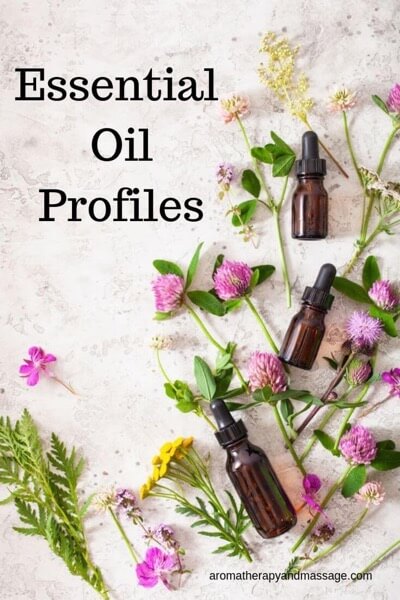- Home
- Essential Oil Profiles
As an affiliate with Bookshop, Amazon, and other programs, I may earn revenue from qualifying purchases through affiliate links. This does not affect the price you pay. Privacy Policy / Disclosures. This site is for educational purposes only.
Search this site:
Essential Oils Uses and Benefits Guide
Welcome to my guide to essential oils uses and benefits. I'm putting together profiles of as many essential oils and absolutes as I can. This page gives you links to those profiles.

What Are Essential Oils?
Essential oils are highly concentrated liquids extracted from plants. For the plants, the oils serve purposes such as helping the plant thrive and protecting it from the environment.
The word "essential" doesn't mean necessary or required for humans. "Essential" comes from the poetic way of thinking about the "essence" or "life force" of a plant.
Some oils, such as jasmine and benzoin, used in aromatherapy technically aren't essential oils but are absolutes extracted from plant material using a solvent. I have included absolutes.
Don't confuse essential oils or absolutes with infused or macerated oils. These oils are vegetable oils with the fragrance of a plant infused into the oil by soaking the plant material in the oil. Infused oils often make good aromatherapy carrier oils.
Essential Oils Uses and Benefits Guide
Here's the list of more than 130 essential oils and absolutes profiled on this website:
- Agarwood Essential Oil
- Allspice Essential Oil (pimento berry)
- Amyris Essential Oil
- Angelica Essential Oil
- Anise Essential Oil
- Balsam Fir Essential Oil
- Basil Essential Oil
- Bay Laurel Essential Oil
- Bay Essential Oil (West Indian)
- Bergamot Essential Oil
- Bergamot Mint Essential Oil
- Benzoin Absolute
- Betel Leaf Essential Oil
- Birch Essential Oil
- Black Pepper Essential Oil
- Black Spruce Essential Oil
- Blue Spruce Essential Oil
- Blue Tansy Essential Oil
- Cajeput Essential Oil
- Calamus Essential Oil
- Calendula Oil
- Camphor Essential Oil
- Cannabis Essential Oil
- Caraway Essential Oil
- Cardamom Essential Oil
- Carrot Seed Essential Oil
- Cassia Essential Oil
- Catnip Essential Oil
- Cedarwood Essential Oil
- Celery Seed Essential Oil
- Chamomile: German Chamomile Essential Oil and Roman Chamomile Essential Oil and Moroccan Chamomile Essential Oil and Cape Chamomile Essential Oil
- Cinnamon Essential Oil
- Cistus Essential Oil
- Citronella Essential Oil
- Citrus Essential Oils: Introduction to oils made from citrus fruits. Also see specific citrus oil profiles.
- Clary Sage Essential Oil
- Clove Essential Oil
- Coffee Essential Oil
- Copaiba Essential Oil
- Coriander Essential Oil
- Cornmint Essential Oil
- Cumin Essential Oil
- Curry Leaf Essential Oil
- Cypress Essential Oil
- Davana Essential Oil
- Dill Essential Oil
- Elemi Essential Oil
- Eucalyptus Essential Oil
- Fennel Essential Oil
- Fingerroot Essential Oil
- Fir Essential Oils
- Fragonia Essential Oil
- Frankincense Essential Oil
- Galbanum Essential Oil
- Galangal Essential Oil
- Geranium Essential Oil and Rose Geranium Essential Oil
- Ginger Essential Oil
- Goldenrod Essential Oil
- Grapefruit Essential Oil
- Helichrysum Essential Oil
- Hinoki Essential Oil
- Ho Wood Essential Oil
- Holy Basil Essential Oil (Tulsi)
- Honey Myrtle Essential Oil
- Hyssop Essential Oil
- Inula Essential Oil
- Jasmine Absolutee
- Juniper Essential Oil
- Kaffir Lime Essential Oil (Combava)
- Kanuka Essential Oil
- Katafray Essential Oil
- Kunzea Essential Oil
- Lavandin Essential Oil
- Lavender Essential Oil
- Ledum Essential Oil
- Lemon Essential Oil
- Lemon Myrtle Essential Oil
- Lemon Tea Tree Essential Oil
- Lemon Verbena Essential Oil
- Lemongrass Essential Oil
- Lime Essential Oil
- Lotus Oil (Pink, White, and Blue Absolutes)
- Magnolia Essential Oil
- Mandarin Essential Oil
- Manuka Essential Oil
- Marjoram Essential Oil
- Massoia Bark Essential Oil
- May Chang Essential Oil
- Melissa Essential Oil
- Mimosa Absolute
- Monarda Essential Oil
- Muhuhu Essential Oil
- Myrrh Essential Oil
- Myrtle Essential Oil
- Nagarmotha Essential Oil
- Neroli Essential Oil
- Niaouli Essential Oil
- Nutmeg Essential Oil
- Oakmoss Absolute
- Ocotea Essential Oil
- Opopanax Essential Oil
- Orange: Sweet Orange Essential Oil and Bitter Orange Essential Oil
- Oregano Essential Oil
- Palmarosa Essential Oil
- Palo Santo Essential Oil
- Parsley Essential Oil
- Patchouli Essential Oil
- Peppermint Essential Oil
- Peru Balsam Essential Oil
- Petitgrain Essential Oil
- Pink Pepper Essential Oil
- Scotch Pine Essential Oil and Other Pine Essential Oils
- Plai Essential Oil
- Ravensara Essential Oil
- Ravintsara Essential Oil
- Rosalina Essential Oil
- Rose Essential Oil
- Rosemary Essential Oil
- Rosewood Essential Oil
- Sage Essential Oil
- Sandalwood Essential Oil
- Saro Essential Oil
- Savory Essential Oil
- Spearmint Essential Oil
- Spike Lavender Essential Oil
- Spikenard Essential Oil
- Tangerine Essential Oil
- Tagetes Essential Oil
- Tarragon Essential Oil
- Tea Tree Essential Oil
- Thyme Essential Oil
- Tonka Bean Absolute
- Turmeric Essential Oil
- Valerian Essential Oil
- Vanilla Absolute
- Vetiver Essential Oil
- Wintergreen Essential Oil
- Yarrow Essential Oil
- Ylang Ylang Essential Oil
- Yuzu Essential Oil
Image Credit: lizashush / 123RF Stock Photo
